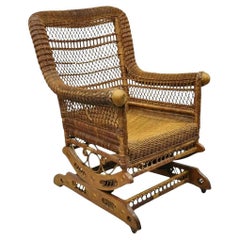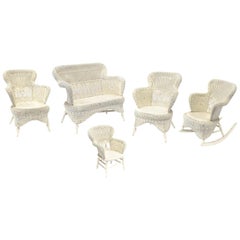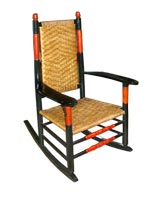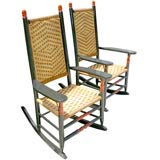Rockers Heywood Wakefield
Antique Late 19th Century Unknown Victorian Rocking Chairs
Wicker
Antique 1890s American Victorian Rocking Chairs
Wicker
Recent Sales
Early 20th Century American Rocking Chairs
Early 20th Century American Rocking Chairs
Early 20th Century American Armchairs
Metal
Mid-20th Century American American Colonial Rocking Chairs
Wood, Paint
Vintage 1960s American Mid-Century Modern Lounge Chairs
Faux Leather, Teak
Antique 19th Century American Late Victorian Rocking Chairs
Wicker
Vintage 1950s American Mid-Century Modern Lounge Chairs
Aluminum
Vintage 1950s American Mid-Century Modern Lounge Chairs
Aluminum
Antique Late 19th Century American Mission Armchairs
Upholstery, Wicker
Antique Late 19th Century American Victorian Rocking Chairs
Early 20th Century American Other Patio and Garden Furniture
Upholstery, Wicker, Reed, Wood
Vintage 1920s American American Classical Rocking Chairs
Wicker
Early 20th Century American Rocking Chairs
Reed, Paint, Wood
Vintage 1920s American Patio and Garden Furniture
Early 20th Century American Chairs
Wood
Early 20th Century American Chairs
Maple
Early 20th Century American Rocking Chairs
Willow
Antique 19th Century American Victorian Rocking Chairs
Wicker
Vintage 1920s American Chairs
Metal
Vintage 1920s Patio and Garden Furniture
People Also Browsed
20th Century American Victorian Benches
Iron
Antique Late 19th Century American Victorian Chairs
Wicker
Early 20th Century American Victorian Chairs
Wicker
Antique 19th Century Irish Armchairs
Upholstery, Yew
Antique 1870s English Victorian Bookcases
Mahogany
2010s British Louis XVI Beds and Bed Frames
Wood
Antique 1870s Belgian Renaissance Revival Bookcases
Brass
Antique 1890s American Victorian Side Tables
Wicker, Beads
Antique Early 1900s Victorian Sofas
Wicker, Rattan, Bentwood
Antique 19th Century American Easels
Iron
Antique 19th Century French Louis XVI Panelling
Stone
Antique 19th Century American Victorian Patio and Garden Furniture
Wicker
Antique Mid-19th Century American Victorian Rocking Chairs
Wicker
Antique 1880s English Aesthetic Movement Bedroom Sets
Walnut
Antique Early 1900s French Art Nouveau Coat Racks and Stands
Brass, Bronze
Antique Late 19th Century American Victorian Loveseats
Wicker
Rockers Heywood Wakefield For Sale on 1stDibs
How Much is a Rockers Heywood Wakefield?
Finding the Right Seating for You
With entire areas of our homes reserved for “sitting rooms,” the value of quality antique and vintage seating cannot be overstated.
Fortunately, the design of side chairs, armchairs and other lounge furniture — since what were, quite literally, the early perches of our ancestors — has evolved considerably.
Among the earliest standard seating furniture were stools. Egyptian stools, for example, designed for one person with no seat back, were x-shaped and typically folded to be tucked away. These rudimentary chairs informed the design of Greek and Roman stools, all of which were a long way from Sori Yanagi's Butterfly stool or Alvar Aalto's Stool 60. In the 18th century and earlier, seats with backs and armrests were largely reserved for high nobility.
The seating of today is more inclusive but the style and placement of chairs can still make a statement. Antique desk chairs and armchairs designed in the style of Louis XV, which eventually included painted furniture and were often made of rare woods, feature prominently curved legs as well as Chinese themes and varied ornaments. Much like the thrones of fairy tales and the regency, elegant lounges crafted in the Louis XV style convey wealth and prestige. In the kitchen, the dining chair placed at the head of the table is typically reserved for the head of the household or a revered guest.
Of course, with luxurious vintage or antique furnishings, every chair can seem like the best seat in the house. Whether your preference is stretching out on a plush sofa, such as the Serpentine, designed by Vladimir Kagan, or cozying up in a vintage wingback chair, there is likely to be a comfy classic or contemporary gem for you on 1stDibs.
With respect to the latest obsessions in design, cane seating has been cropping up everywhere, from sleek armchairs to lounge chairs, while bouclé fabric, a staple of modern furniture design, can be seen in mid-century modern, Scandinavian modern and Hollywood Regency furniture styles.
Admirers of the sophisticated craftsmanship and dark woods frequently associated with mid-century modern seating can find timeless furnishings in our expansive collection of lounge chairs, dining chairs and other items — whether they’re vintage editions or alluring official reproductions of iconic designs from the likes of Hans Wegner or from Charles and Ray Eames. Shop our inventory of Egg chairs, designed in 1958 by Arne Jacobsen, the Florence Knoll lounge chair and more.
No matter your style, the collection of unique chairs, sofas and other seating on 1stDibs is surely worthy of a standing ovation.
- 1stDibs ExpertFebruary 13, 2023Heywood-Wakefield closed in 1981 when the company went bankrupt. The furniture maker is well known for their rattan and wicker furniture as well as for their blond wood casegoods made from maple and birch wood. On 1stDibs, find a selection of Heywood-Wakefield furniture.
- 1stDibs ExpertApril 5, 2022Heywood Wakefield furniture is made of solid wood, which means the best approach to cleaning it is to use a damp cloth and a small amount of mild dish soap for clean-up. Do not get the wood overly wet or it can warp or wet spots may develop. Shop a collection of Heywood Wakefield furniture from some of the world’s top sellers on 1stDibs.
- 1stDibs ExpertApril 5, 2022Heywood-Wakefield furniture is an American brand founded in 1897. The mid-century modern furniture manufacturer uses sustainable, durable Northern Yellow birch, which gives its pieces a rich yellow color. Shop a collection of Heywood-Wakefield furniture from some of the world’s top sellers on 1stDibs.
- 1stDibs ExpertSeptember 23, 2024To identify a Heywood-Wakefield chair, you can first look for a maker's mark. Beginning in 1949, the manufacturer began affixing paper labels to the undersides of chair seats. These labels usually feature the brand name along with an eagle logo. Unfortunately, the paper labels tended to come loose over time, so not all chairs will feature them, and pieces produced before 1949 are usually unmarked. If you can't find a marking, examine the hardware that holds the chair together. Heywood-Wakefield typically used Phillips head screws, so the presence of other types of fasteners will usually indicate that a different manufacturer produced the chair. In addition, the maker only utilized solid wood to construct its chairs. If you see plywood or veneers, your chair is probably not a Heywood-Wakefield. Because it can be difficult to identify an unmarked chair on your own, you may wish to have a certified appraiser or knowledgeable antique dealer assist you. Explore a range of Heywood-Wakefield chairs on 1stDibs.
- 1stDibs ExpertFebruary 13, 2023To identify Heywood-Wakefield wicker furniture, look for the maker's mark. It will either be printed on a paper label or stamped onto the piece in an inconspicuous area like the bottom or back. Pieces made after 1949 normally have the company name positioned inside of an eagle. Earlier furnishings will likely just show the maker's name. If you're unsure whether a specific piece is authentic, a certified appraiser or experienced antique dealer can assist you. Shop a range of Heywood-Wakefield furniture on 1stDibs.
- 1stDibs ExpertFebruary 1, 2024To identify Heywood-Wakefield furniture, search for the maker's mark. You will typically find it on a paper label or stamped directly onto an inconspicuous part of the piece, such as under the seat or tabletop. Early pieces usually display the company's name on its own, while those manufactured after 1949 will often have an eagle logo along with the Heywood-Wakefield wordmark. If questions about authentication remain, a certified appraiser or experienced antiques dealer can assist you. Explore a diverse assortment of Heywood-Wakefield furniture on 1stDibs.
- 1stDibs ExpertFebruary 13, 2023Heywood-Wakefield started making furniture in 1897. The company formed from the merger of two rattan furniture manufacturers, Heywood Brothers and Wakefield Company. Both companies were in Massachusetts. On 1stDibs, find a collection of Heywood-Wakefield furniture.
- 1stDibs ExpertApril 5, 2022Yes, Heywood-Wakefield uses solid wood to create its furniture. The lumber used for the designs is sustainable and harvested from farms in New Hampshire. You can shop a collection of Heywood-Wakefield furniture from some of the world’s top sellers on 1stDibs.
- 1stDibs ExpertFebruary 13, 2023Heywood-Wakefield furniture was made from a variety of woods. However, the furniture maker's acclaimed blond wood casegoods were made from birch and maple wood. On 1stDibs, find a selection of Heywood-Wakefield furniture.
Read More
All the Furniture in This Organic Modern Soho Loft Can Be Yours
Andrianna Shamaris has filled her epic new home with pieces of her own design.
20 Inviting Dining Rooms Perfectly Arranged for Entertaining
Top interior designers show — and tell — us how to create delectable spaces for hosting dinner parties.
Nobody Puts This Sunny Sofa in a Corner
With its plush cushions, cane details and dazzlingly colorful back, it’s inviting from every angle.
The 21 Most Popular Mid-Century Modern Chairs
You know the designs, now get the stories about how they came to be.
Fred Rigby’s Modular Seating Can Be Configured in So Many Handy Ways
The plush Cove Slipper 2.5 Seater sofa is just one of many convenient combinations from the London-based maker.
This Chubby-Chic Quilted Stool Stands on Its Own Two Feet
Sam Klemick's cool stool is edgy, cozy and environmentally sustainable all at once.
Is Lionel Jadot the Willy Wonka of Upcycled Belgian Design?
From his massive collaborative workshop in a former paper factory, the designer concocts funky furniture from disused materials, as well as luxe hotel interiors like the new Mix Brussels.
Rock Your Cares Away on This Sunny Hand-Crocheted Swing
The boho-chic Enchanted Forest Swing, handmade by marginalized women from Turkey and Syria, is uplifting in every way.



